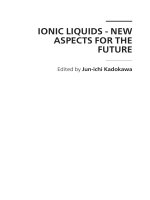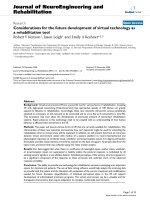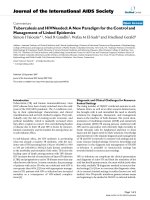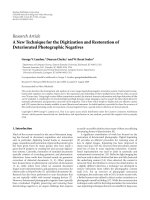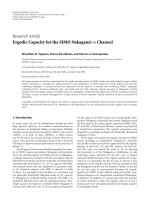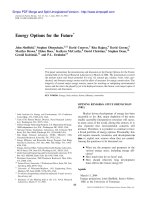IONIC LIQUIDS - NEW ASPECTS FOR THE FUTURE pdf
Bạn đang xem bản rút gọn của tài liệu. Xem và tải ngay bản đầy đủ của tài liệu tại đây (35.94 MB, 706 trang )
IONIC LIQUIDS - NEW
ASPECTS FOR THE
FUTURE
Edited by Jun-ichi Kadokawa
Ionic Liquids - New Aspects for the Future
/>Edited by Jun-ichi Kadokawa
Contributors
Anna Martinelli, Jun-ichi Kadokawa, Tateki Ishida, Fatemeh Moosavi, Elaheh Kowsari, Clarissa Piccinin Frizzo, Dayse N.
Moreira, Marcos Antonio Pinto Martins, Izabelle Gindri, Aniele Tier, Lilian Buriol, Madhulata Shukla, Satyen Saha,
Hisashi Miyafuji, Yinghuai Zhu, Narayan Hosmane, Hidetaka Noritomi, Chuan-Pei Lee, Te-Chun Chu, Ling-Yu Chang,
Jiang-Jen Lin, Kuo-Chuan Ho, Ana P.M. Tavares, Oscar Rodriguez, Eugénia A. Macedo, Nicholas Gathergood,
Rohitkumar G. Gore, Jefferson Trindade Filho, Guilherme Caleffi, Toshiro Kaneko, Rikizo Hatakeyama, Shinya Sasaki,
Yuriko Kondo, Takahiro Koyama, Takaya Sato, Takashi Morinaga, Takeo Ishizuka, Changwei Hu, Liangfang Zhu, Mihai
Putz, Ana-Maria Putz (n. Lacrama), Pedro Mancini, María N. Kneeteman, Claudia D. Della Rosa, Carla Ormachea, Adam
McCluskey, Ahmed Al Otaibi, Susumu Kuwabata, Iuliana Cota, Rafael Gonzalez-Olmos, Miguel Iglesias, Francesc
Medina, Vicky Lange, Pete Licence, Barry Azzopardi, Ana P. C. Ribeiro, Carlos Nieto De Castro, Salomé I.C. Vieira, Maria
J.V. Lourenço, Fernando J. V. Santos, Sohel S.M. Murshed, Peter Goodrich, Christopher Hardacre, João M. França
Published by InTech
Janeza Trdine 9, 51000 Rijeka, Croatia
Copyright © 2013 InTech
All chapters are Open Access distributed under the Creative Commons Attribution 3.0 license, which allows users to
download, copy and build upon published articles even for commercial purposes, as long as the author and publisher
are properly credited, which ensures maximum dissemination and a wider impact of our publications. After this work
has been published by InTech, authors have the right to republish it, in whole or part, in any publication of which they
are the author, and to make other personal use of the work. Any republication, referencing or personal use of the
work must explicitly identify the original source.
Notice
Statements and opinions expressed in the chapters are these of the individual contributors and not necessarily those
of the editors or publisher. No responsibility is accepted for the accuracy of information contained in the published
chapters. The publisher assumes no responsibility for any damage or injury to persons or property arising out of the
use of any materials, instructions, methods or ideas contained in the book.
Publishing Process Manager Iva Lipovic
Technical Editor InTech DTP team
Cover InTech Design team
First published February, 2013
Printed in Croatia
A free online edition of this book is available at www.intechopen.com
Additional hard copies can be obtained from
Ionic Liquids - New Aspects for the Future, Edited by Jun-ichi Kadokawa
p. cm.
ISBN 978-953-51-0937-2
free online editions of InTech
Books and Journals can be found at
www.intechopen.com
Contents
Preface IX
Section 1 Fundamental Properties 1
Chapter 1 The Dynamical Properties on Ionic Liquids: Insights from
Molecular Dynamics Study 3
Tateki Ishida
Chapter 2 Modeling of Ionic Liquid Systems: Phase Equilibria and Physical
Properties 31
Filipa M. Maia, Noelia Calvar, Emilio J. González, Aristides P.
Carneiro, Oscar Rodriguez and Eugénia A. Macedo
Chapter 3 A Comparative Study of Piperidinium and Imidazolium Based
Ionic Liquids: Thermal, Spectroscopic and
Theoretical Studies 61
Madhulata Shukla and Satyen Saha
Chapter 4 Spectral-Structure Activity Relationship (Spectral-SAR)
Assessment of Ionic Liquids’ in Silico Ecotoxicity 85
Ana-Maria Putz and Mihai V. Putz
Chapter 5 Tribological Properties of Ionic Liquids 127
Yuriko Kondo, Tahahiro Koyama and Shinya Sasaki
Chapter 6 Hydrodynamics of Ionic Liquids in Bubble Columns 143
Vicky Lange, Barry J. Azzopardi and Pete Licence
Chapter 7 Synthesis, Properties and Physical Applications of
IoNanofluids 165
Carlos Nieto de Castro, Ana P. C. Ribeiro, Salomé I.C. Vieira, João M.
P. França, Maria J.V. Lourenço, Fernando V. Santos, Sohel M.S
Murshed, Peter Goodrich and Christopher Hardacre
Chapter 8 The Structure of Supported Ionic Liquids at the Interface 195
Fatemeh Moosavi
Section 2 Energies, Fuels, and Biomass Conversions 231
Chapter 9 Ionic Liquids for Green Energy Applications - Local Structure
and Dynamics by Advanced Spectroscopic Techniques 233
Anna Martinelli
Chapter 10 Solid-State Ionic Liquid Based Electrolytes for Dye-Sensitized
Solar Cells 257
Chuan-Pei Lee, Te-Chun Chu, Ling-Yu Chang, Jiang-Jen Lin and
Kuo-Chuan Ho
Chapter 11 Recent Advances in the Science and Technology of
Desulfurization of Diesel Fuel Using Ionic Liquids 277
Elaheh Kowsari
Chapter 12 Liquefaction of Wood by Ionic Liquid Treatment 299
Hisashi Miyafuji
Chapter 13 Applications of Ionic Liquids in Lignin Chemistry 315
Zhu Yinghuai, Karen Tang Yuanting and Narayan S. Hosmane
Section 3 Organic Reactions and Biological Applications 347
Chapter 14 Ionic Liquids: “Green” Solvent for Catalytic Oxidations with
Hydrogen Peroxide 349
Liangfang Zhu and Changwei Hu
Chapter 15 New Brønsted Ionic Liquids: Synthesis, Thermodinamics and
Catalytic Activity in Aldol Condensation Reactions 365
I. Cota, R. Gonzalez-Olmos, M. Iglesias and F. Medina
Chapter 16 Protic and Nonprotic Ionic Liquids in Polar Diels-Alder
Reactions Using Properly Substituted Heterocycles and
Carbocycles as Dienophiles. A DFT study 391
Pedro M. E. Mancini, Carla M. Ormachea, Claudia D. Della Rosa,
María N. Kneeteman and Luis R. Domingo
ContentsVI
Chapter 17 Ionic Liquids as Doping Agents in Microwave Assisted
Reactions 433
Marcos A. P. Martins, Jefferson Trindade Filho, Guilherme S. Caleffi,
Lilian Buriol and Clarissa P. Frizzo
Chapter 18 Multicomponent Reactions in Ionic Liquids 457
Ahmed Al Otaibi and Adam McCluskey
Chapter 19 Safer and Greener Catalysts – Design of High Performance,
Biodegradable and Low Toxicity Ionic Liquids 499
Rohitkumar G. Gore and Nicholas Gathergood
Chapter 20 New Generations of Ionic Liquids Applied to Enzymatic
Biocatalysis 537
Ana P.M. Tavares, Oscar Rodríguez and Eugénia A. Macedo
Chapter 21 Pharmaceutical Salts: Solids to Liquids by Using Ionic
Liquid Design 557
Clarissa P. Frizzo, Izabelle M. Gindri, Aniele Z. Tier, Lilian Buriol,
Dayse N. Moreira and Marcos A. P. Martins
Chapter 22 Increase in Thermal Stability of Proteins by Aprotic
Ionic Liquids 581
Hidetaka Noritomi
Section 4 Materials and Processing 595
Chapter 23 Use of Ionic Liquid Under Vacuum Conditions 597
Susumu Kuwabata, Tsukasa Torimoto, Akihito Imanishi and Tetsuya
Tsuda
Chapter 24 Plasma Process on Ionic Liquid Substrate for Morphology
Controlled Nanoparticles 617
Toshiro Kaneko, Shohei Takahashi and Rikizo Hatakeyama
Chapter 25 Ionic-Liquid-Assisted Synthesis of Hierarchical Ceramic
Nanomaterials as Nanofillers for Electromagnetic-Absorbing
Coatings 633
Elaheh Kowsari
Contents VII
Chapter 26 Ionic Liquids as Components in Fluorescent Functional
Materials 653
Jun-ichi Kadokawa
Chapter 27 Preparation, Physicochemical Properties and Battery
Applications of a Novel Poly(Ionic Liquid) 673
Takaya Sato, Takashi Morinaga and Takeo Ishizuka
ContentsVIII
Preface
Concerns with ionic liquids are one of the most interesting and rapidly developing areas in
modern physical chemistry, materials science, technologies, and engineering. Increasing
attention has also been paid to the use of ionic liquids in the research fields of biological
aspects and natural resources. This book provides the forum for dissemination and
exchange of up-to-date scientific information on theoretical, generic, and applied areas of
ionic liquids. It, therefore, tends to review recent progresses in ionic liquid research on
fundamental properties, solvents and catalysts in organic reactions, biological applications,
providing energies and fuels, biomass conversions, functional materials, and other
applications. I trust that this book will provide an active source of information for research
in ionic liquid science and engineering.
Prof. Dr. Jun-ichi Kadokawa
Kagoshima University
Kagoshima, Japan
Section 1
Fundamental Properties
Chapter 1
The Dynamical Properties on Ionic Liquids: Insights
from Molecular Dynamics Study
Tateki Ishida
Additional information is available at the end of the chapter
/>1. Introduction
Ionic liquids (ILs) have attracted many researchers in the areas including physics and chem‐
istry because of their characteristics that are different from conventional molecular liquids
and, today, ILs have been one of interesting subjects of scientific study. ILs are consisted of
ions and liquids at or near room temperature, and show negligible vapor pressure, thermal
and chemical properties, and so on [1-8]. Also, ILs have been widely used as solvents for
organic reactions with the expectation of high yields [1]. Most interesting features of ILs can
be attributed to remarkable interionic interactions, and these can be an important key factor
to study the characteristics of ILs at molecular level. From the results of both experimental
and theoretical investigations, it has been recognized that the interionic interaction of ILs
could determine physical and chemical properties.
From an experimental side, both femtosecond optically heterodyne-detected Raman-in‐
duced Kerr effect spectroscopy (OHD-RIKES)[3, 9, 10] and THz time-domain spectroscopy
(THz-TDS)[11, 12] have been applied to investigate the intermolecular vibrational dynamics
in ILs. In particular, with OHD-RIKES studies, the possibility to control a property such as
shear viscosity by substituting an atomic element in an ionic unit has been reported [13, 14].
On the other hand, from theoretical and computational viewpoints in recent years, ILs have
been chosen to study static properties such as structural and thermophysical proper‐
ties[15-18] and novel interionic dynamics under solvation dynamics [19-21], dynamical
properties [22-26], and Kerr spectra analyses [14, 27]. It has been suggested from the simula‐
tion studies by Ishida et al. [14] that interionic properties in ILs could be effectively adjusta‐
ble by substituting an atomic unit in an ion unit in addition to a combination of cations and
anions. Also, it has been pointed out that the interplay of motions between cation and anion
species could play an important role in specific interionic interactions of ILs.[28]
© 2013 Ishida; licensee InTech. This is an open access article distributed under the terms of the Creative
Commons Attribution License ( which permits unrestricted use,
distribution, and reproduction in any medium, provided the original work is properly cited.
Now, we can consider two factors important to understand specific interionic interactions in
ILs. One is the interionic interaction depending on specific correlations such as cross-correla‐
tion terms between cations and anions, and the other is polarization effects due to many-
body interactions caused by cations and anions in ILs. While a large number of experimental
approaches have been applied to investigate these subjects, molecular-level understanding
of many specific properties of ILs has been left unresolved. Obviously, theoretical researches
are suitable to tackle these problems to which experimental procedures are not accessible.
Thus, it is expected that such computational method as molecular dynamics (MD) simula‐
tions enables us to obtain significant information of ILs, utilizing the force field with well-
parameterized potential functions and partial charges [29].
With the MD simulation procedures, it is possible to study the effects of the cross-correla‐
tions on dynamic collective motions of ions in ILs which are considered to govern the
strength and behavior of couplings between ionic motions through interionic interactions
[28]. The computation of the time correlations of velocity and momentum between a tagged
ion and other unlike ions at different distances provides cross-correlation and momentum
correlation functions [28, 30, 31]. Utilizing these calculated functions, we can investigate not
only interionic interactions at molecular level but also how collective motions in ILs can pro‐
ceed accompanied by the momentum transfer between ions in the target IL system.
On the other hand, electrostatic interactions between ions in ILs could be modulated due to
many-body interactions and, then, it could emerge as polarization effects caused by the distor‐
tion of electron densities under anisotropic environment in ILs. It has been pointed out that the
inclusion of polarization effects is significant to investigate the characteristics of ILs in structur‐
al and dynamical properties [23, 24]. Therefore, it is required for us to carry out the MD simula‐
tion, introducing such procedures as a point dipole model and a polarization energy term into
the total potential energy representation of the system [32]. In addition to electrostatic interac‐
tions, describing the variation and relaxation of the polarizability anisotropy of ILs is impor‐
tant to investigate dynamics in ILs. For achieving this, we need to compute time-dependent
polarization effects on a target system due to environmental effects in ILs. Theoretically, when
we would take polarizability anisotropy into account, to track the change of molecular polariz‐
ability tensor partly dependent on molecular orientations such as rotational motions would be
required. With the calculation of the time correlation function (TCF) of off-diagonal elements
of the total polarizability of the system, we can investigate collective properties with the result
of the polarizability anisotropy relaxation of the system.
In this chapter, we choose a 1-butyl-3-methylimidazolium cation based ILs with hexafluoro‐
phosphate anion, [BMIm][PF
6
], and bis(trifluoromethylsulfonyl)amide anion, [BMIm][NTf
2
],
as target systems. (See Figure 1 for all the molecular structures of [BMIm]
+
, [PF
6
]
–
and
[NTf
2
]
–
.) Firstly, we focus on the collective properties of [BMIm][PF
6
] with the cross-correla‐
tion functions of ionic species in the IL and polarization effects on ionic motions. As a sec‐
ond, we investigate dynamical properties of [BMIm][NTf
2
]. Below, we start from the
explanation for the velocity cross-correlations of a central atom with neighboring atoms.
Then, we show how to evaluate both cross-correlation and momentum correlation functions
of the target IL. In addition, we describe the introduction of a polarization energy term and
Ionic Liquids - New Aspects for the Future4
the procedure to calculate induced dipole moments and the polarization energy. Following
those, the theoretical background of polarization TCFs is given. Computational details are
also summarized. In later sections, we discuss polarization effects on interionic interactions
and specific properties related to those based on the MD simulation results. We show com‐
putation results obtained from performing MD simulation and computing the polarization
TCF with the dipole-dipole (DID) approximation [4,5]. Also, we examine the relation be‐
tween the anisotropic polarizability relaxation and collective motions of ionic species. Last‐
ly, we discuss relaxation processes of ILs including an explanation of important points in
studying dynamical properties on ILs.
Figure 1. Molecular structures and definitions of body-fixed coordinate axes: (a) [BMIm]
+
, (b) [PF
6
]
–
and (c) [NTf
2
]
–
. (See
text.) In [BMIm]
+
, the Y direction is along the line connecting two nitrogen (blue colored) atoms in the ring, and the Z
direction is set perpendicular to the ring plane and the Y direction axis. The X directionis set in the ring plane orthogo‐
nal to both the Y and the Z axes. In [PF6]
–
, the X, Y, and Z direction axes are set equivalently. In [NTf
2
]
–
, the Y axis is
along the line connecting two sulfurs (dark yellow colored), and the Z axis is set perpendicular the S-N-S plane and the
X axis. The X axis is set in the S-N-S plane orthogonal to both the Y and Z axes.
2. Tracking Ionic Motions Through Interionic Interactions: Cross-
Correlation, Polarization Effects, and Dynamical Properties
As mentioned in the previous section, for many problems of ILs to which experimental pro‐
cedures are not accessible, theoretical investigations with computer simulation procedures
are promising and suitable to obtain detailed information at molecular level. In particular,
specific correlations such as cross-correlations between cations and anions seem not to be
feasible to detect experimentally, but the MD simulations enable us to evaluate those. Also,
for tracing dynamics in ILs such as librational and reorientational dynamics of ionic species,
The Dynamical Properties on Ionic Liquids: Insights from Molecular Dynamics Study
/>5
cross-correlated ionic motions, and the influence of polarization coming from many-body ef‐
fects caused by cations and anions in ILs from a microscopic point of view, the MD simula‐
tions are considered to be one of useful and powerful tools. In this chapter, we will show
and explain the dynamical properties on ILs based on MD simulation results taking into
consideration mainly following points:
1. how can cross-correlated ionic motions in ILs be modified by interionic dynamics and
electronic polarizability effects ?
2. how can the collective dynamics through interionic interactions in ILs be tracked by
computer simulation procedures ?
3. what kinds of properties with simulation data do we have to check and care in the in‐
vestigation of dynamical properties of ILs ?
4. what kinds of subjects of ILs can be or should be investigated theoretically, considering
important properties of ILs experimentally observed ?
The items 1 and 2 are main parts in this chapter, including the key results mentioned above.
The item 3 is considered to be important for suggesting (or notifying) attention to researchers
who are working on analyzing the dynamical properties on ILs. The item 4 includes future per‐
spectives. In particular, we will show and discuss new aspects of ILs in each section related to
the items 1, 2, and 3. Also, some of theoretical backgrounds and computational procedures for
studying the dynamical properties of ILs are given in each related section, below.
At first, let us consider following points:
1. how can the collective dynamics through interionic interactions cause the unique physi‐
cal and chemical properties of ILs ?
2. how can interionic dynamics be modified by electronic polarizability effects ?
The former includes the investigation of the contribution of ionic motions due to Coulombic
interactions to velocity cross-correlation functions. In particular, through the analysis of the
longitudinal and nonlongitudinal contributions to the velocity cross-correlation function in
ILs, we will be able to investigate interionic interactions in detail. Also, important properties
for physical and chemical interests such as case effects seems to be within the scope of
unique collective dynamics in ILs. The later covers the relation between polarizability corre‐
lation functions and interionic interactions for ILs. To investigate these points, we can utilize
useful information for static properties obtained from computer simulations, but those are
not often enough to extract the details of specific interactions.
Here, we give an example that it is difficult for us to find the importance of the interactions be‐
tween cation and anion species only from static properties. Figure 2 displays the computed ra‐
dial distribution functions, g(r), comparing non-polarizable model with polarizable model
[28]. As shown in the figure, we can observe only small difference in RDFs between two mod‐
els, except that the g(r) of cation-anion is different from those of cation-cation and anion-anion
as easily deduced. But, obviously, it is not feasible for us to observe information other than
strong spatial correlations and sequential ordering of cation and anion pairs. In addition, the
Ionic Liquids - New Aspects for the Future6
analysis of averaged static structures such as RDFs is not enough to investigate remarkable po‐
larization effects such as screening effects influenced by polarization. Below, we give a sche‐
matic explanation and discuss that to consider interionic interactions with cross-correlation
analyses is important to investigate the interplay between cation and anion species in ILs, and
it is shown that the cross-correlation analyses provide contrastive features.
Figure 2. Radial distribution functions (rdfs) for the center of mass of [BMIm][PF
6
] for both nonpolarizable (np) and
polarizable (p) models: (a) [BMIm]
+
- [PF
6
]
–
and (b) [BMIm]
+
- [BMIm]
+
and [PF
6
]
–
- [PF
6
]
–
.
Different from a usual velocity autocorrelation functions (VACF), cross-correlation func‐
tions describe interactions between unlike (ionic) species (that is, between a cation and an
anion in ILs) and show opposite features to VACFs. In Figure 3, these features are ex‐
plained schematically. Here, it should be emphasized that cross-correlation functions pro‐
vide more information on interionic interactions than that static properties such as RDFs
include. As seen in Figure 3 ((a) and (b)), the variation of cross-correlation function corre‐
lates with the alteration of the VACF. In particular, the cross-correlation function shows
the increasing toward the maximum peak where the VACF approaches a minimum point.
The Dynamical Properties on Ionic Liquids: Insights from Molecular Dynamics Study
/>7
These features indicate that it is possible for us to track the time evolution of cross-corre‐
lations (between cation and anion species in ILs) as collective dynamics. In addition, it is
observed in Figure 3 ((c)) that a particle (ionic species) is bouncing back and forth be‐
tween like and unlike particles (ions). This implies collective (ionic) motions between co‐
ordination shells, thus, it is indicated that not only interionic interactions but also
momentum transferring among ionic species could be extracted by analyzing cross-corre‐
lation functions. Also, considering that these cross-correlation functions could be modulat‐
ed by the strength of interionic interactions and the coupling between cation and anion
motions, cross-correlation functions would be largely influenced by polarization effects.
Figure 3. Schematic explanation for a cross-correlation and a VACF: (a) short-time region: an ion approaches a coun‐
ter ion, and, at the same time, the VACF decreases, (b) the cross-correlation functions start decreasing after the maxi‐
mum (see text) and (c) bounced ions again approaches counter ions.
On the other hand, as another type of the appearance of interplay between cross-correla‐
tion and polarization effects, we consider the polarizability anisotropy and its relaxation
of an IL system. These correspond to the variation of the sum of molecular polarizability
depending on time. Therefore, it is required to compute the change of molecular polari‐
zablity on each molecule due to interionic interactions and interaction-induced multipole
effects. Obviously, it is expected that molecular polarizabilites are influenced by interionic
cross-correlations. In later sections, we introduce the theoretical background of polariza‐
bility TCF and its application to the study of ILs, and show how degree these are effec‐
tive and discuss the importance of considering cross-correlations.
3. Theoretical Background
Here, we introduce cross-correlation functions, and then, give an explanation of a polariza‐
ble model and polarizability time correlation function. Computational details are also given.
Ionic Liquids - New Aspects for the Future8
3.1. Cross-Correlation Function
A velocity autocorrelation function (VACF) is defined for calculating the velocity correlation
of a same particle as follows,
( )
1
C v ( ) v (0) v (0) v (0)
ii i i
tt
-
=××
(1)
where v
i
(t) is the velocity of i-th species. Different from the VACF, the time cross-correlation
functions between the velocity of a central species i and the velocity of a neighboring species
j different from the particle i is defined as follows [30, 31],
( )
( )
22
1/ 2
CR v (0) v ( ) v v
n
ij
n i j ij
tt
-
= ×
(2)
where v
i
(t) is the velocity of the species i and v
j
(t) is the velocity of the species j. v
i
2
and v
j
2
represent the mean square velocities. Here, it should be noted that
n
represents a restricted
statistical average [30, 31],
( )
( )
( )
( )
v (0) v ( ) v (0) v (0) 0 0 /
i j i j ij ij
n
nn n
j
t r a br N
× = × -× -
å
(3)
where θ represents the step function. a
n
and b
n
are set as the positions of the nth minima of
the radial distribution function of the system, g(r). The N
n
in Eqs. (2) and (3) is the coordina‐
tion number in the region between r = a
n
and b
n
. as follows,
( )
2
4
n
n
b
n
a
N r g r dr
pr
=
ò
(4)
where ρ is the number density of the system.
Here, we can define the cross-correlation in ILs as that between a centered cation and the
total contribution of other anions [28, 30],
( )
( )
22
1/ 2
CA
C A CA
CR v (0) v ( ) v v
n
nn
tN t
-
= ×
(5)
where “C” and “A” in super- and subscript represent cation and anion, respectively. By in‐
terchanging “C” and “A” in super- and subscript in the above equation, we can easily derive
the formulation for the cross-correlation between a centered anion and other cations.
Also, with the computation of the cross-correlation functions between the velocity of a cen‐
tral ion and velocities of neighboring distinct ions, we can analyze the momentum transfer
The Dynamical Properties on Ionic Liquids: Insights from Molecular Dynamics Study
/>9
between distinct ions in ILs. Introducing the momentum correlation function [28, 31], the
transfer of the momentum of a cation to distinct cations and anions is defined as follows,
( )
( )( )
( ) ( )
1
C( ) CC CA 2
(CC) (CA)
(0) ( ) (0) ( )
nn
total
nn n
cation cation cation anion
nn
P tNpptNpptp
P tP t
-
++ +-
+
®®
= ×+ ×
=+
(6)
where p
+
and p
‒
mean the momentums of cation and anion, respectively. The transference
of momentum of an anion to distinct anions and cations, P
n
A(total)
(t), is also given as follows,
( )
( )( )
( ) ( )
1
A( ) AA AC 2
(AA) (AC)
(0) ( ) (0) ( )
nn
total
nn n
anion anion anion cation
nn
P tNpptNpptp
P tP t
-
++ +-
+
®®
= ×+ ×
=+
(7)
3.2. Polarization Effects
3.2.1. A Polarizable Model
Here, we introduce a polarizable model considering induced dipole moments and explain
the procedure for computing induced dipole moments and the many-body polarization
energy [33-35].
The total potential energy of the system under the resulting polarizable force field is defined
as follows,
tot bond nonbond pol
VV V V=+ +
(8)
where the terms V
bond
and V
nonbond
are intra- and intermolecular interaction energies. The po‐
larization energy, V
pol
, is decomposed into the three terms as follows,
pol charge dipole dipole dipole self
VV V V
= ++
(9)
where the charge-dipole contribution, V
charge-dipole
, the dipole-dipole contribution, V
dipole-dipole
,
and the self-polarizability term, V
self
, are defined, respectively, as
charge dipole i i
i
VE
m
-
=-×
å
(10)
dipole dipole i ij j
ij
VT
mm
-
>
= ××
å
(11)
Ionic Liquids - New Aspects for the Future10
1
2
self i i
i
i
V
mm
a
= ×
å
(12)
In the above equations, E
i
is the electric field on atom i, produced by the partial charges of
all other surrounding atoms, and μ
i
represents the induced dipole moment on atom i. Also,
α
i
means the isotropic atomic polarizability of atom i. In Eq. (11), the T
ij
, is the dipole field
tensor element defined as follows,
32
3
1
1
ij ij
ij
ij ij
T
rr
éù
êú
= -
êú
ëû
rr
(13)
where r
ij
= r
i
– r
j
. The induced dipole moment on atom i is given by
i i i ij j
ji
ET
ma m
¹
æö
ç÷
= -
ç÷
èø
å
(14)
With Eqs. (10), (11), and (12), the polarization energy, E
pol
, is summarized as follows,
1
2
pol i i
i
VE
m
=-×
å
(15)
3.2.2. Polarizability Time-Correlation Function (TCF)
The polarizability anisotropy of the system can be tractable by calculating the TCF of off-
diagonal elements of the total polarizability. Here, the theoretical background of the polariz‐
ability TCF is summarized briefly.
At first, we define the total polarizability of the system, Π(t), that is the sum of the molecu‐
lar polarizability, Π
M
(t), and the interaction-induced polarizability, Π
II
(t), as follows,
() () ()t tt
M II
P =P +P
(16)
where t represents the time dependence, and subscripts M and II mean the molecular part
and the interaction-induced part, respectively. The molecular part is given by the sum of the
polarizability tensors of isolated gas phase molecular polarizability in the laboratory frame,
The Dynamical Properties on Ionic Liquids: Insights from Molecular Dynamics Study
/>11
1
() ()
N
i
i
tt
a
M
=
P=
å
(17)
where N is the number of molecules, and α
i
is the polarizability tensor of molecule i. For the
formulation of the interaction-induced part, we employ the dipole-induced-dipole (DID)
model approximation [36, 37], which assumes that the molecular polarizabilities are modi‐
fied due to a dipolar coupling with the influence of higher order unconsidered. The interac‐
tion-induced polarizability in the DID approximation is given as follows,
II
1
() () () ()
NN
i ij j
i ji
t tTt t
aa
= ¹
P= × ×
åå
%
(18)
where T
ij
means the dipole interaction tensor between molecules i and j. α
˜
i
(t)is the effec‐
tive polarizability for molecule i defined by the following equation including the interac‐
tion-induced effects,
() () () () ()
N
i i i ij j
ji
t t tTt t
aa a a
¹
= + ××
å
%%
(19)
Equation (19) can be solved by the calculation procedure that is called the all-orders DID ap‐
proximation [37]. It should be noted that the DID model employed here assumes a center-
center DID model, where it recognizes the polarizability as concentrated in the center of
mass of the molecule.
Here, we give the representation of the total system polarizability including the cationic and
anionic components [14, 27],
CA
() () ()tttP =P +P
(20)
where the superscripts C and A represent cation and anion species, respectively. Referring
to Equations. (16), (17), and (18), the Π
C
(t) and Π
A
(t) defined as follows,
C C(M) C(II)
1
() ( () ())
ii
i
t tt
aa
=
P= +
å
(21)
A A(M) A(II)
1
() ( () ())
jj
j
t tt
aa
=
P= +
å
(22)
Ionic Liquids - New Aspects for the Future12
where the indices k and l go over all cations and anions, respectively. Then, the total polariz‐
ability of the system, Π(t), can be rewritten, as follows,
( )
( )
{ }
( )
{ }
( )
CA
C CA A
C A CA
1
() Tr () ()
3
11
() Tr () () Tr ()
33
1
Tr () () () ()
3
t tt
t tt t
tt tt
bb
P = P +P
+P-P +P-P
= P +P + +
I
II
I
(23)
Where
β
C
(t)=
{
Π
C
(t)−
1
3
Tr
(
Π
C
(t)
)
I
}
and
β
A
(t)=
{
Π
A
(t)−
1
3
Tr
(
Π
A
(t)
)
I
}
and I is the unit ten‐
sor. Finally, the polarizability TCF, ϕ(t), can be rewritten as follows,
( ) ( )
( ) ( )
( ) ( )
C A CA
CC AA
CA AC
C A C-A
() Tr (0) (0) () ()
Tr (0) ( ) Tr (0) ( )
Tr (0) ( ) Tr (0) ( )
() () ()
t tt
tt
tt
tt t
f
b b bb
bb bb
bb bb
fff
= + ×+
= ×+ ×
+ ×+ ×
=++
éù
ëû
(24)
where
ϕ
C
(t)= Tr
(
β
C
(0)⋅β
C
(t)
)
ϕ
A
(t)= Tr
(
β
A
(0)⋅β
A
(t)
)
ϕ
C−A
(t)= Tr
(
β
C
(0)⋅β
A
(t)
)
+ Tr
(
β
A
(0)⋅β
C
(t)
)
The nuclear response function, R(t), is represented as the time derivative of the polarizabili‐
ty TCF,
1
() ()
B
Rt t
kT t
f
¶
= -
¶
(25)
3.3. Computational Details
Utilizing the sets of force field parameters for [BMIm]
+
, [PF
6
]
–
and [NTf
2
]
–
[38-40], MD simu‐
lations have been performed with the DL_POLY molecular dynamics suite [41]. In all the
simulations, all the stretching bonds were constrained with the SHAKE algorithm [42]. 125
ion pairs (4000 atoms for [BMIm][PF
6
] and 5000 for [BMIm][NTf
2
]) were set in a cubic box
under the periodic boundary condition. The lengths of cubic box size were set to be 35.47
The Dynamical Properties on Ionic Liquids: Insights from Molecular Dynamics Study
/>13
and 38.46 Å to reproduce the experimental data of the densities of [BMIm][PF
6
] and [BMIm]
[NTf
2
] at 298 K [13, 43]. 12 Å was set as cutoff length. The time step was 2 fs. The long-range
Coulomb and polarization terms were computed with the Ewald’s summation technique
[44]. Firstly, each system was equilibrated at 600 K for 15 ns in the NVE run and then succes‐
sively cooled down to 298 K in several stages using velocity scaling. Then, 20 ns NVT run
for equilibration at 298 K was carried out. After these equilibration runs, trajectories were
recorded every 20 fs (50 fs for [BMIm][NTf
2
]) and collected during 10 ns (20 ns for [BMIm]
[NTf
2
]) production runs. For atomic polarizabilities, from the literature [45, 46], we adopted
1.152, 0.705 and 0.0885 Å
3
for the C, N, and H atoms of the cation, respectively, and 0.121
and 3.630 Å
3
for the F and P atoms of the anion, respectively. We considered the distance
and vector between the atomic sites of distinct molecules in the dipole interaction tensor,
T=(I −3r
^
r
^
)
/
r
3
, wherer
^
=r / rThen, the range of the attenuation of dipolar interactions at
short distances, s, was evaluated with the Thole’s definition [47], s = 1.662(α
i
α
j
)
1/6
with atom‐
ic polarizabilities, α
i
andα
j
. Also, the dipole interaction tensor we used is given by [47]
3
ˆˆ
T ( 3 )/ ( )rrs=->I rr
(28)
34 4 3
ˆˆ
T (4a 3a ) 3a / ( )rrs
éù
= £
ëû
I rr
(29)
where a = r/s. Equation (14) is solved with an iterative procedure at each time step, and then,
the criterion value of iterative solution for induced dipole moment was set to 0.001 D. For
the computation of the polarizability TCF of [BMIm][NTf
2
], we used molecular polarizabili‐
ties of 14.372 Å
3
for [BMIm]
+
and 11.259 Å
3
for [NTf
2
]
–
.[48] The body-fixed coordinate axes
set in the cation and the anion are shown in Figure 2. For more computational procedures in
detail, interested readers should refer to references [14] and [28].
4. Cross-Correlation, Momentum Correlation, and Polarization Effects
The computed velocity cross-correlation functions [28] are shown in Figures 4 and 5.
These figures show the comparison of velocity cross-correlation functions observed
around the cation, [BMIm]
+
, and the anion, [PF
6
]
–
, placed at the center, for both the non‐
polarizable and polarizable models. From the result of the cation-anion RDF in Figure 2,
we selected 3.5, 8.4, 8.4, and 14.75 Å for the value of a
1
, b
1
, a
2
, and b
2
in Equation (4) for
the nonpolarizable model, respectively, and 3.5, 8.5, 8.5, and 15.0 Å for the polarizable
model, respectively. With these values, the first (C
1
(t)) and second (C
2
(t)) coordination
shells were specified. It should be noted that the C
1
(t) between the center anion and dis‐
tinct anions is not shown in Figure 5 because the C
1
(t) is almost zero corresponding to the
result that the anion-anion RDF result is almost zero at the region of the specified first co‐
ordination shell (see RDFs in Figure 2(b)). Also, it should be noted that the initial values,
C
n
(0), are negative since the system size is finite as have been pointed out [30].
Ionic Liquids - New Aspects for the Future14
Figure 4. The Calculated velocity cross-correlation functions between the [BMIm]
+
set at the center in the first coordi‐
nation shell and [PF
6
]
–
, and between the center cation and other cations, including VACF: (a) in the nonpolarizable
model and (b) in the polarizable model.
As shown in Figures 4 and 5, the VACFs are also displayed for comparison. As briefly ex‐
plained in Section 2 with Figure 3, the initial rise of the cross-correlation function, C
1
(t),
appears toward the maximum for both models, corresponding to the decay of the VACF
to the minimum (see the (a) and (b) in Figure 3). These results indicate that the initial mo‐
mentum of the central ion is gained by neighboring ions immediately after t = 0. In addi‐
tion, following decay profiles (see the (c) in Figure 3) are seen. These are ascribed to the
spread of transferred momentum to the outer coordination shells. The peak height of the
C
1
(t) in the polarizable model is larger than that in the nonpolarizable model. These sig‐
nificant results indicate that the momentum transfer can be intensified from the more dis‐
tant coordination shells to the first ones due to both the charge-dipole and dipole-dipole
interactions by polarization effects in addition to charge-charge Coulomb interactions. As
the characteristics of the VACF profile, it is noted that the minima of the VACF are locat‐
ed at the positions later than those of the maxima of the velocity cross-correlation func‐
tions for the first coordination shell. These features imply that the momentum transmitted
to the neighbors at the first shell is regained partly by the central cation or anion, bounc‐
The Dynamical Properties on Ionic Liquids: Insights from Molecular Dynamics Study
/>15



